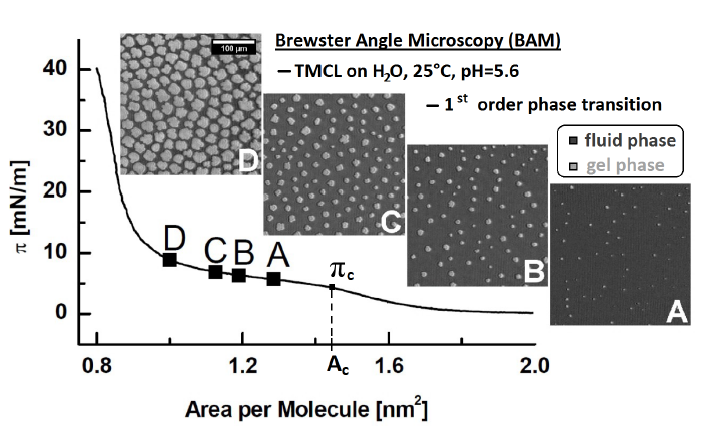Project B1
Doctoral researcher: Florian Gellert
Principle investigator: Christiane A. Helm
Co-supervisors: C. H. Lillig, U. Bornscheuer
Effect of ROS on supramolecular structure of model membranes
Background: One of the main effects of ROS on cell membranes is the peroxidation of unsaturated lipids. The chemical changes have been carefully studied and are known, especially at the beginning and the end of the process[1]. Peroxidation of the unsaturated molecules increases the molecular area of a lipid molecule[2]. However, the effects of these chemical changes on the physical properties of the membranes are still little understood. Both structure (e.g. domains) and function (e.g. elastic properties and membrane permeability) are affected. As a simplified model of membranes we use lipid monolayers, which are especially suitable to study 2D phase separation which may underlie the raft hypothesis of cell membrane organization[3]. Similar to natural membranes the monolayers are composed of a mixture of cholesterol, saturated and unsaturated lipids.
Preliminary Results: Observing a lipid monolayer with Brewster angle microscopy, we found domains[4]. Using image analysis software, we quantified domain morphology and area fraction in liquid/liquid (possibly liquid/glass) and liquid/ordered phases. The 2D phase separation depends strongly on temperature, kind and concentration of salt in the subphase as well as molecular area.
Goal:We plan to investigate how the changes on a molecular level influence 2D phase separation. In a first step we need to find a reliable method to quantify the amount of oxidative species introduced. The effects of the peroxidation are explored for monolayers with different composition, starting with simple mixtures and increasing the complexity to approach mitochondrial membranes (with C2).
Work Plan:A low temperature plasma jet (kINPen®) will be used to form reactive species. To quantity the effect of produced radicals (ROS and RNS)[5]on the isotherms, we will start with standard mixtures of lipids (saturated and unsaturated cholines, cholesterol) and measure the area increase.Addition of charged lipids to the membrane will lead to a dependency of 2D phases and phase separation on ions in solution4. A high concentration of unsaturated lipids may induce chain reactions1. The monolayers are investigated on the macroscopic and molecular scale with complementary techniques: different phases are studied by isotherms, domains by Brewster angle microscopy, the vertical electron density profile with X-ray reflectivity, different ordered phases by grazing incidence X-ray diffraction[6].This project will gain from the cooperation with other RTG groups, e.g. Scholz, Delcea, Lendeckel, Lillig.
Literature
[1] AW Girotti (1998)Lipid hydroperoxide generation, turnover, and effector action in biological systems.J. Lipid Res. 39, 1529.
[2] CK Haluska, MS Paptista, AU Fernandes, AP Schroder, CM Marques and R Itri (2012) Photo-activated phase separation in giant vesicles made from different lipid mixtures. BBA 1818, 666
[3] IC Shieh, JA Zasadzinski (2015) Visualizing monolayers with a water-soluble fluorophore to quantify adsorption, desorption, and the double layer. PNAS 112, E826
[4] R Kensbock, H Ahrens and CA Helm, (2017) in preparation
[5] MU Hammer, E Forbrig, S Kupsch, KD Weltmann, S Reuter. (2013) Influence of plasma treatment on the structure and function of lipids. Plasma Medicine,3, 97
[6] A Gröning, H Ahrens, T Ortmann, F Lawrenz, G Brezesinski, F Scholz, CA Helm. Molecular mechanisms of phosphatidylcholine monolayer solidification due to hydroxyl radicals (2011) Soft Matter 7, 6467
Contact
Prof. Dr. Christiane A. Helm (Speaker)
University of Greifswald
Institute of Physics
Felix-Hausdorff-Strasse 6
DE-17487 Greifswald, Germany
Tel: +49 (0)3834 420 4710
Fax:+49 (0)3834 86 4712
helm(at)uni-greifswald(dot)de
Website

